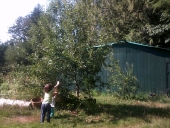
 3
3




 4
4




T S Rodriguez wrote:Hi all, what are the differences, the good and the bad, with dwarf, semi-dwarf, and standard apple trees?
I have heard but do not know what is true.
Dwarf and semi-dwarf do not live as long as standard. Is this true? How much shorter?
Standard has a longer productive life than other varieties. Is this true? How much longer?
I have heard that dwarf and semi-dwarf trees are not as healthy, and more susceptible to disease. Is this true?
When you reach your lowest point, you are open to the greatest change.
-Avatar Aang
 2
2





 3
3




This is all just my opinion based on a flawed memory

 6
6




If there is one thing the Wizard of Oz has taught me, it is not to trust school teachers on bicycles.
 4
4




 1
1




Mark William wrote:
Are "dwarf" and "semi-dwarf" genetic traits? Are seedlings grown from the fruit of dwarf and semi-dwarf trees also dwarf and semi-dwarf? Do root suckers from dwarf and semi-dwarf trees retain that attribute?
 1
1




This is all just my opinion based on a flawed memory

 1
1




Ben Zumeta wrote:Anyone know if dwarfing is generally a recessive or dominant trait?
When you reach your lowest point, you are open to the greatest change.
-Avatar Aang








This is all just my opinion based on a flawed memory






|
Oh. Hi guys! Look at this tiny ad:
Homestead Pastured Poultry course
https://permies.com/wiki/364740/Homestead-Pastured-Poultry
|





